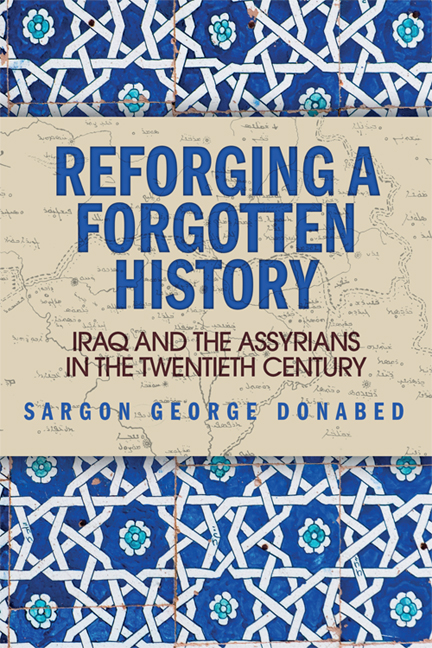Book contents
- Frontmatter
- Contents
- List of Figures
- List of Tables
- Abbreviations
- Acknowledgements
- Dedication
- Map
- Introduction
- 1 Integrating the Assyrian Question
- 2 Framing the Assyrian Narrative: Late Nineteenth and Early Twentieth Century
- 3 Iraq: Building a ‘Nation’-State
- 4 The Birth of the Republic and an Autonomist Struggle
- 5 Enduring Discord: Political Machinations and Border Clearings
- 6 New Movements and War on the Horizon
- 7 State Formation, State-building and Contentious Pluralism
- 8 Conclusion
- Glossary
- Appendix A Village Data
- Appendix B Documents Concerning Cultural and Political Organisations
- Bibliography
- Index
2 - Framing the Assyrian Narrative: Late Nineteenth and Early Twentieth Century
Published online by Cambridge University Press: 05 September 2016
- Frontmatter
- Contents
- List of Figures
- List of Tables
- Abbreviations
- Acknowledgements
- Dedication
- Map
- Introduction
- 1 Integrating the Assyrian Question
- 2 Framing the Assyrian Narrative: Late Nineteenth and Early Twentieth Century
- 3 Iraq: Building a ‘Nation’-State
- 4 The Birth of the Republic and an Autonomist Struggle
- 5 Enduring Discord: Political Machinations and Border Clearings
- 6 New Movements and War on the Horizon
- 7 State Formation, State-building and Contentious Pluralism
- 8 Conclusion
- Glossary
- Appendix A Village Data
- Appendix B Documents Concerning Cultural and Political Organisations
- Bibliography
- Index
Summary
It was an ill day for his tribe when he led them to fight in a war for the liberty of small nations. Now we have to meet death at long last, so let us prepare to face the enemy whom we know, that we may the more readily forget the desertion of those whom we once thought to be our friends.
Yaqo Ismael translating for his father, Malik Ismael, of Upper Tiyari, 1932Assyrian Demography: Between Deteriorating Empires and Colonial Expansion
Contextualising the Assyrians, starting in the late nineteenth century in the region of Iraq, begins by distinguishing them socially and geographically (which sometimes includes dialect and ecclesiastical adherence) into two major categories. While the two groups had a notion of shared ancestry there were some distinctions that waxed and waned throughout the centuries.
The first group comprised those centred in and around the cities of Mosul, Arbil, Kirkuk, Zakho and Dohuk in modern-day Iraq, most of whom were converted from the Church of the East/Nestorianism (though bastions of Nestorians remained in and around the Barwar and Sapna regions and elsewhere) or Orthodoxy (referred to predominantly as Jacobite) to Catholicism primarily via Dominican missions. Many were urban dwellers, some having lost their native Assyrian-Aramaic language to Arabic and were thus Arabised. Others who had retained their mother tongue lived in large semi-rural regions.
The second category of Assyrians hailed from the region of Hakkâri in today's southeastern Turkey and Urmia in northwestern Iran. They fled during the Great War into what would become Iraq. They were typically rural, predominantly of Nestorian ecclesiastical background in Hakkâri with some Uniate Catholics, while the Urmia Assyrians numbered many Protestants, Catholics and Russian Orthodox. The Hakkâri segment also made up the bulk of the Iraqi Levies in the latter years of their institution, alongside Assyrians of Barwar and Sapna.
In both cases, the Assyrians were native to the region of northern Mesopotamia, which would later find itself divided by Western political entities during colonial expansion. Not unlike the scramble for Africa following the Berlin Conference in 1884, Assyrians, like many native African peoples, found themselves fragmented by arbitrarily created boundaries that would become the basis for internal and external components of otherisation.
- Type
- Chapter
- Information
- Reforging a Forgotten HistoryIraq and the Assyrians in the Twentieth Century, pp. 54 - 92Publisher: Edinburgh University PressPrint publication year: 2015



